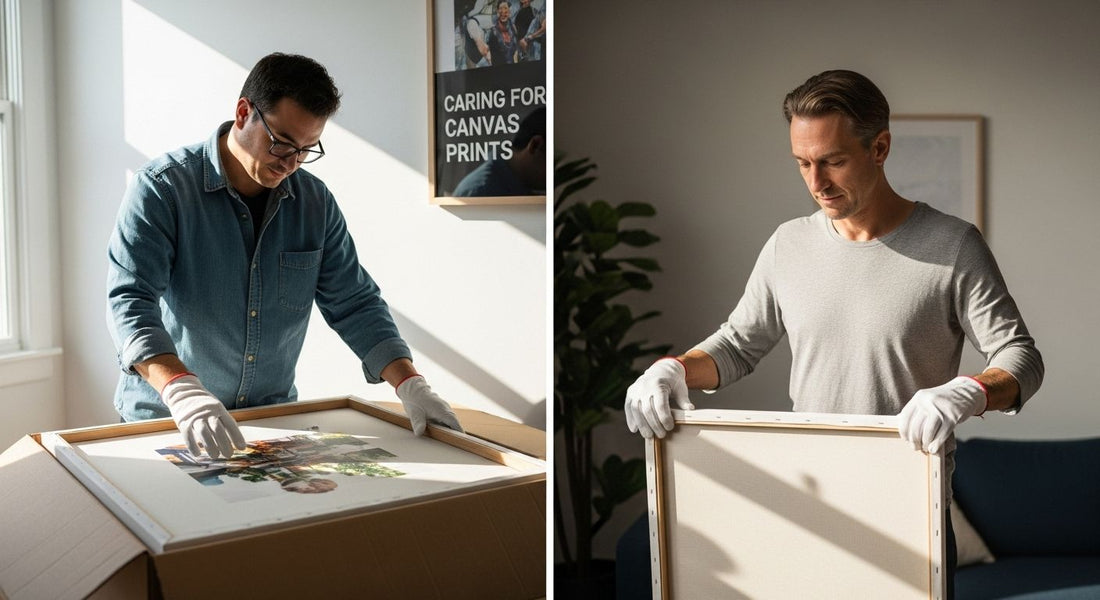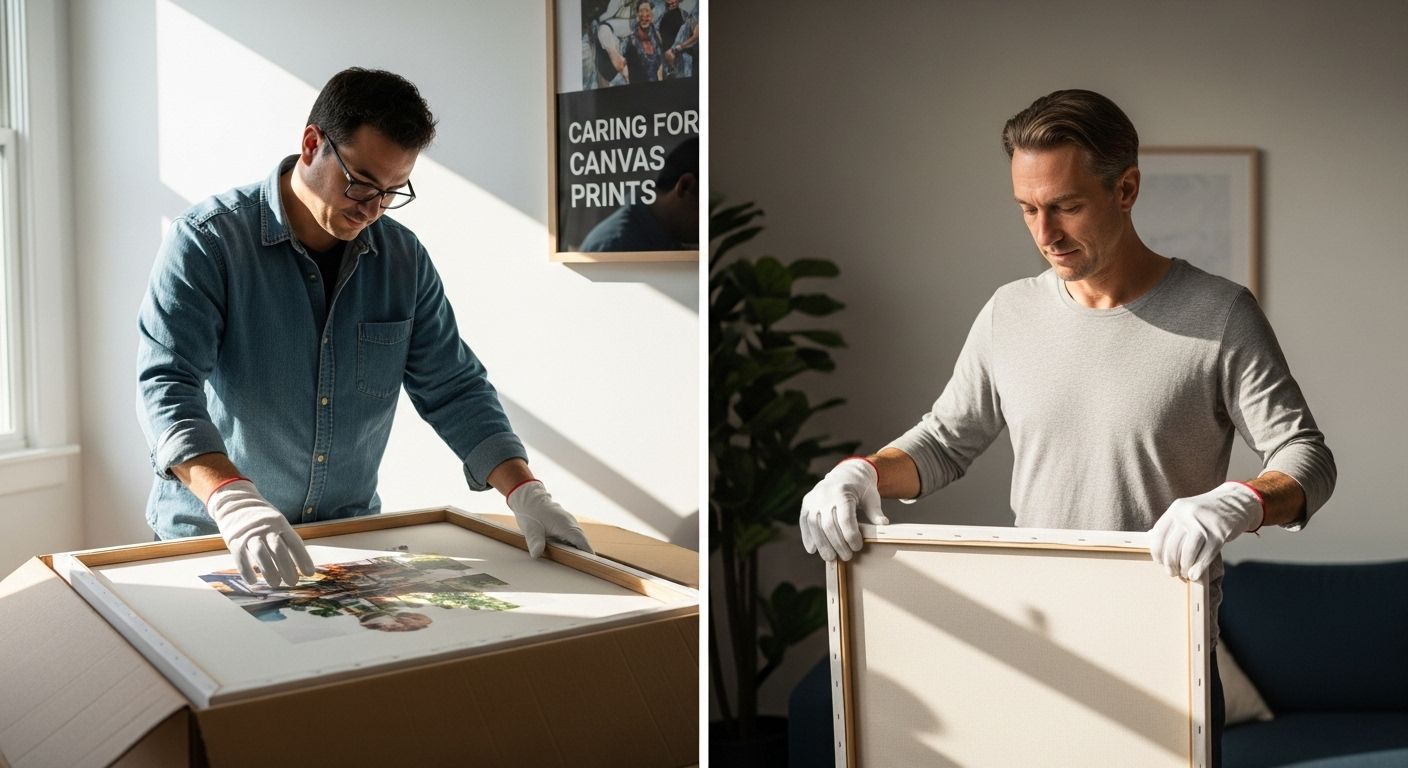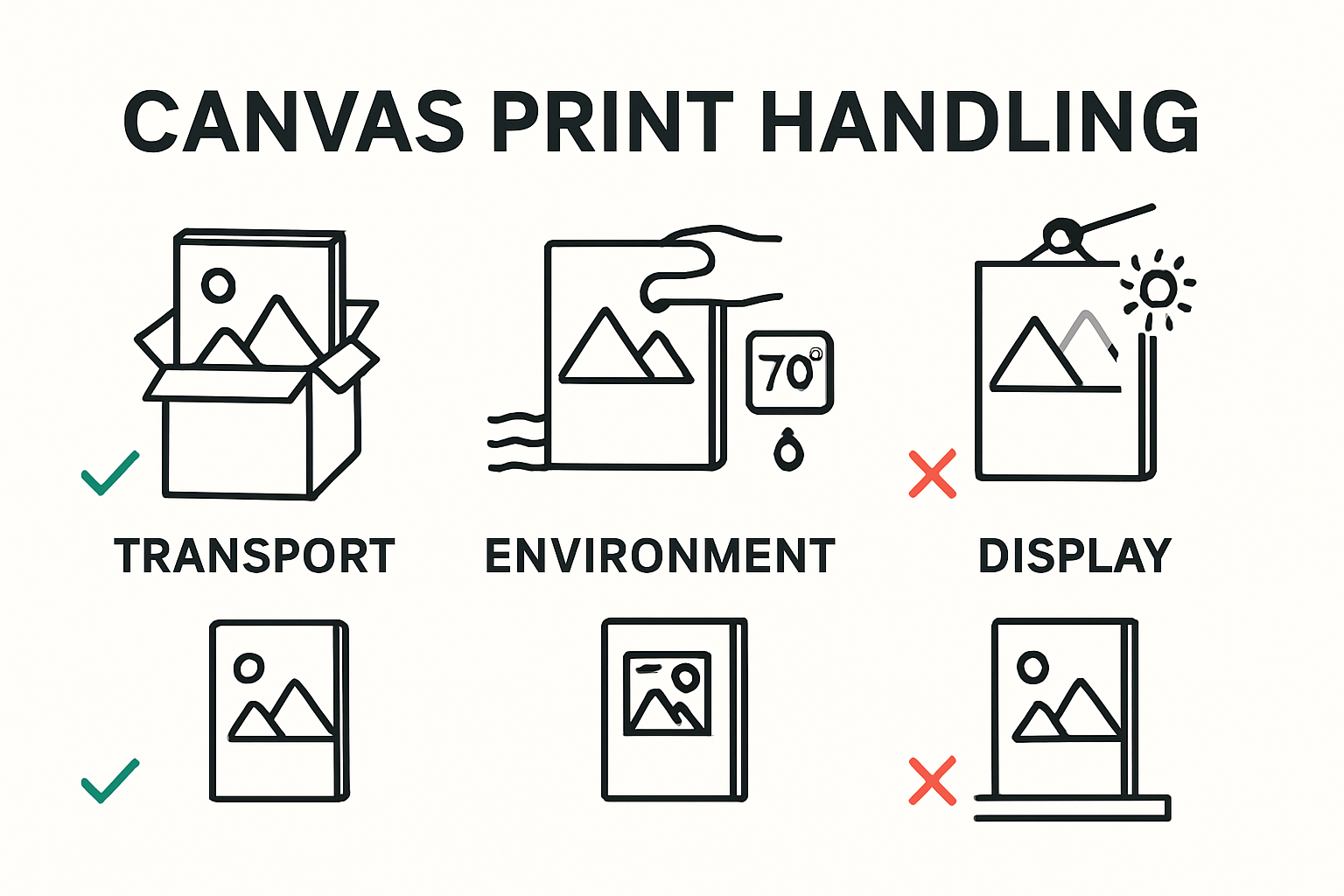
Caring for Canvas Prints: Expert Tips for 2025

Canvas prints bring color and life to any room and they are more popular than ever before. You might think keeping them looking new is simple and takes little effort. But research shows nearly 40 percent of canvas prints lose vibrancy within five years when neglected and handling mistakes can ruin valuable artwork in seconds. The real secret is that with just a few expert tips, your favorite prints can look as stunning in 2025 as the day you hung them.
Table of Contents
- Essential Handling and Display Tips
- How to Clean Canvas Prints Safely
- Protecting Canvas Art from Damage
- Long-Term Care for Luxury Canvas Prints
Quick Summary
| Takeaway | Explanation |
|---|---|
| Use precision when transporting canvas prints. | Always employ safe techniques like A-frame trolleys or two-person carrying methods to prevent damage during transportation. |
| Avoid direct sunlight and extreme conditions. | Display artwork in areas with soft, indirect lighting and consistent temperatures to preserve colors and prevent canvas warping. |
| Implement gentle cleaning techniques regularly. | Dust your canvas prints using a soft microfiber cloth to maintain their appearance and prevent dirt accumulation. |
| Schedule professional assessments every few years. | High-value prints should be evaluated for preservation needs by experts to address potential issues early. |
| Document your canvas prints for future reference. | Keeping a record of provenance, assessments, and condition photos aids in preservation and may enhance value. |
Essential Handling and Display Tips
Caring for canvas prints requires more than just aesthetic appreciation. Proper handling and display techniques protect your investment and preserve the artwork’s beauty for years to come. From the moment you acquire a canvas print to its final placement in your home, each step demands careful consideration and thoughtful approach.
Safe Transportation and Initial Handling
Transporting canvas prints demands precision and caution. The Canadian Conservation Institute recommends using specialized moving equipment like A-frame trolleys for heavy or oversized artworks. When professional equipment is unavailable, always employ a two-person carrying technique. Each person should strategically place hands along the lower edge and side corners to distribute weight evenly and maintain balanced control.
When moving canvas prints, wear clean cotton gloves to prevent transferring oils or dirt onto the artwork’s surface. Avoid touching the canvas directly, instead handling the frame or stretcher bars. Always lift the print from its sides, never from the top, which could cause unnecessary stress on the canvas material.
Strategic Display Considerations
Collaborative Art Creations emphasizes the critical importance of thoughtful placement when displaying canvas prints. Direct sunlight can be particularly damaging, causing gradual color fading and potential canvas degradation. Position your artwork in areas with indirect, soft lighting to maintain its vibrant appearance.
Temperature and humidity play pivotal roles in canvas print preservation. Avoid hanging prints in environments with extreme fluctuations, such as near heat sources, air vents, or in rooms with high moisture content like bathrooms and kitchens. These spaces can cause canvas stretching, warping, or potential mold growth. Ideal display locations maintain consistent temperatures between 65-75 degrees Fahrenheit with relative humidity around 50%.
Protective Positioning and Environment
The placement of your canvas print matters significantly beyond aesthetic considerations. The Canadian Conservation Institute warns against hanging artwork in high-traffic areas where accidental brushing or touching might occur. Narrow corridors, stairwells, and spaces with frequent movement increase the risk of potential damage.
Consider the surrounding environment carefully. Avoid proximity to cooking areas with persistent fumes, direct heat sources, or locations prone to sudden environmental changes. Use appropriate hanging hardware that supports the print’s weight, ensuring secure mounting that prevents unexpected falls or shifts. When possible, choose wall spaces away from direct drafts or areas with significant temperature variations.
By implementing these essential handling and display tips, you transform from a mere art owner to a responsible art curator. Each careful action contributes to preserving the intricate details, vibrant colors, and emotional resonance of your canvas prints, ensuring they remain stunning visual narratives for years to come.

How to Clean Canvas Prints Safely
Cleaning canvas prints requires a delicate touch and specialized approach to maintain their pristine appearance and long-term preservation. Unlike traditional framed artwork or standard wall decor, canvas prints demand careful maintenance that protects their unique surface and intricate details.
Gentle Dusting Techniques
Regular dust removal is the first line of defense in canvas print maintenance. Use a soft, clean microfiber cloth or a specialized art cleaning brush with extremely soft bristles to remove surface dust. Always work from the top of the canvas downward using light, gentle strokes. The Canadian Conservation Institute emphasizes the importance of minimal contact, recommending techniques that avoid direct pressure on the canvas surface.
Avoid using standard household dusting tools like feather dusters or rough cloths that might scratch or damage the print’s delicate surface. Electric static dusters can also generate unwanted static electricity that might attract more dust or potentially harm the print’s protective coating. For canvas prints displayed in areas prone to dust accumulation, consider implementing a regular but gentle cleaning schedule every two to four weeks.
Spot Cleaning Without Liquid Damage
When confronting minor stains or spots, professional art conservators recommend an extremely cautious approach. Begin by testing any cleaning method on a small, inconspicuous area of the canvas print. Use a clean, white microfiber cloth very lightly dampened with distilled water. Never saturate the canvas or use household cleaners, which can permanently damage the print’s pigments and protective layers.
For stubborn marks, consult a professional art restoration expert rather than attempting aggressive cleaning techniques. Some canvas prints have delicate ink or pigment layers that can be irreparably damaged by improper cleaning methods. If liquid is necessary, use the absolute minimum amount possible, gently blotting rather than rubbing. Always allow the canvas to air dry completely in a temperature-controlled environment away from direct sunlight or heat sources.
Professional Maintenance and Long-Term Care
Periodic professional inspection can help identify potential preservation challenges before they become significant issues. Art Conservation Experts recommend having valuable or sentimental canvas prints professionally assessed every few years. These experts can provide specialized cleaning, minor restoration, and advice on preventing environmental damage.
Consider attaching a rigid backing to your canvas print, as recommended by conservation professionals. This protective measure reduces the impact of humidity changes and provides an additional layer of physical protection. Store replacement or backup cleaning materials specifically designed for art preservation, such as lint-free microfiber cloths and soft brushes.
By adopting these meticulous cleaning and maintenance strategies, you transform routine care into a form of art preservation. Each careful action protects not just the physical artwork, but the emotional and aesthetic value embedded within your canvas print. Remember that patience, gentleness, and professional guidance are your most valuable tools in maintaining these beautiful visual narratives.
To further clarify canvas maintenance options, the following table summarizes the recommended cleaning methods and what to avoid:
| Cleaning Task | Recommended Method | What to Avoid |
|---|---|---|
| Surface dust removal | Soft microfiber cloth or art cleaning brush | Feather dusters, rough cloths |
| Spot cleaning | Lightly dampened microfiber cloth with distilled water (test small area) | Household cleaners, excessive moisture |
| Stubborn stains | Consult professional conservator | Aggressive scrubbing, liquid solvents |
| Drying after cleaning | Air dry in temperature-controlled area | Direct sunlight, heat sources |
Protecting Canvas Art from Damage
Preserving the integrity of canvas prints requires a comprehensive understanding of environmental factors, handling techniques, and proactive protection strategies. Beyond simple aesthetic maintenance, effective preservation involves creating an optimal environment that minimizes potential damage risks.
Environmental Control and Humidity Management
Museums Galleries Scotland highlights the critical role of relative humidity in artwork preservation. Maintaining humidity levels between 50% and 60% prevents significant damage risks. Extreme humidity conditions can cause substantial harm: high humidity promotes mold growth, while low humidity causes canvas materials to dry out and become brittle.
Temperature stability is equally crucial. Sudden fluctuations can cause canvas materials to expand and contract, potentially leading to structural damage. Aim to keep your canvas prints in spaces with consistent temperatures, typically between 65-75 degrees Fahrenheit. Avoid placing artwork near heating vents, air conditioners, fireplaces, or windows with direct sunlight exposure, as these areas create unpredictable environmental conditions.
Structural Protection and Mounting Techniques
The Smithsonian Museum Conservation Institute emphasizes precise hanging techniques as a fundamental aspect of artwork protection. When mounting canvas prints, secure wall hooks directly into wall studs to ensure maximum stability. Use appropriate painting wire looped through eye screws positioned on the frame’s sides, which distributes weight evenly and prevents unnecessary stress on the canvas fabric.
Discover expert tips for comprehensive art storage to complement your display strategies. Consider adding a rigid backing to your canvas print, as recommended by The Canadian Conservation Institute. A corrugated plastic sheet attached to the back of the canvas can significantly reduce humidity impact and provide an additional layer of physical protection.
Preventative Damage Mitigation
Implement a proactive approach to canvas print protection by creating a comprehensive preservation strategy. Regular inspections can help identify potential issues before they become significant problems. Look for early signs of damage such as slight discoloration, canvas warping, or minute structural changes.
When handling or moving canvas prints, always use clean cotton gloves to prevent oil transfer from skin. Support the artwork from its sides and bottom, avoiding direct pressure on the canvas surface. If transportation is necessary, use specialized art transport materials like padded art carriers or custom-built protective cases that provide shock absorption and temperature regulation.
Additionally, consider the artwork’s surrounding environment. Avoid hanging prints in high-traffic areas where accidental bumping or touching might occur. Keep artwork away from areas with cooking fumes, persistent moisture, or potential chemical exposure that could degrade the print’s quality.
By implementing these comprehensive protection strategies, you transform canvas print preservation from a reactive to a proactive process. Each carefully considered action contributes to maintaining the artwork’s aesthetic beauty, structural integrity, and emotional resonance for years to come. Remember that thoughtful, consistent care is the most effective method of protecting your cherished canvas prints.
To help you implement environmental best practices, below is a summary table outlining optimal conditions and actions to protect canvas prints from damage:
| Factor | Recommended Range/Action | What to Avoid |
|---|---|---|
| Relative Humidity | 50% - 60% | High humidity (mold), low humidity (brittleness) |
| Temperature | 65-75°F, stable | Fluctuations, direct heat/cold |
| Mounting | Hooks into studs, wire through side eye screws | Nails in drywall, stress on top |
| Handling | Use clean cotton gloves, support from sides/bottom | Bare hands on canvas, pressure on surface |
| Placement | Away from traffic, drafts, direct sun, kitchens, bathrooms | Near heat, moisture, chemicals |
| Backing | Add rigid or corrugated plastic sheet | None (leaves canvas unprotected) |
Long-Term Care for Luxury Canvas Prints
Luxury canvas prints represent more than mere decorative elements. They are investments in artistic expression, emotional resonance, and visual storytelling. Ensuring their longevity requires a sophisticated, comprehensive approach that goes beyond standard preservation techniques.
Professional Conservation and Periodic Assessment
The Getty Foundation’s Conserving Canvas initiative underscores the importance of expert conservation knowledge in maintaining canvas artwork. Professional conservators bring specialized skills that go beyond routine maintenance, offering nuanced insights into structural care and potential preservation challenges.
Schedule professional assessments every three to five years, particularly for high-value or sentimental canvas prints. These evaluations can detect early signs of degradation that might be imperceptible to untrained eyes. Conservators use advanced diagnostic techniques to evaluate the canvas’s structural integrity, pigment stability, and potential environmental vulnerabilities.
Advanced Protective Strategies
The Canadian Conservation Institute recommends implementing sophisticated protective measures for luxury canvas prints. Consider using archival-grade backing boards constructed from stable, inert materials. These specialized boards serve multiple protective functions: reducing humidity impact, preventing pollutant infiltration, and providing structural support.
Learn more about advanced canvas art storage techniques to complement your preservation efforts. Invest in museum-quality storage solutions for prints not currently on display. Use acid-free archival boxes, climate-controlled storage environments, and protective sleeves that shield artwork from potential environmental contaminants.
Environmental and Archival Preservation
The Smithsonian Institution’s Museum Conservation Institute emphasizes maintaining environmental conditions that balance human comfort with artwork preservation. Target relative humidity levels between 40% and 60%, which provides an optimal preservation environment. Utilize conservation-grade dehumidifiers or humidity control systems to maintain these precise conditions.
Documentation plays a crucial role in long-term preservation. Create a comprehensive archival record for each canvas print, including provenance, original purchase details, professional assessment reports, and a detailed photographic condition log. This documentation serves not only as a preservation tool but potentially increases the artwork’s historical and monetary value.
Implementing these advanced long-term care strategies transforms canvas print preservation from a reactive maintenance approach to a proactive conservation methodology. Each carefully considered action contributes to protecting the artwork’s aesthetic integrity, structural stability, and potential future value. By treating luxury canvas prints as significant cultural artifacts deserving meticulous attention, you ensure these visual narratives continue to inspire and captivate for generations to come.

Frequently Asked Questions
How do I properly transport my canvas prints?
Always use safe transportation techniques, such as using A-frame trolleys or employing a two-person carrying method where each person supports the artwork from the lower edge and side corners to prevent damage.
What is the best way to clean canvas prints?
For regular cleaning, use a soft microfiber cloth to gently dust the surface. For spot cleaning, use a lightly dampened cloth with distilled water and avoid any household cleaners that could damage the canvas.
How can I protect my canvas prints from fading?
Avoid displaying your canvas prints in direct sunlight or extreme temperature fluctuations. Ideal conditions are areas with soft, indirect lighting and stable temperatures between 65-75°F with relative humidity around 50%.
When should I schedule a professional assessment for my canvas prints?
It is advisable to have high-value or sentimental canvas prints professionally assessed every three to five years. Professionals can help identify early signs of degradation and provide specialized maintenance advice.
Elevate Your Canvas Care with Handcrafted Art That Lasts
Are you searching for canvas prints that not only brighten your home but also stand the test of time? Many art lovers worry about fading colors, warping, or accidental damage—exactly the real challenges discussed in the guide above. At Marta Ellie, we believe that enjoying beautiful artwork in 2025 and beyond starts with both expert care and mindful selection. Discover our Lake House Weekend Retreat Art – Exclusive Canvas Art collection, where each print is created with museum-quality materials and attention to long-term durability. These pieces make it easy to put expert preservation tips into action, so you can focus on enjoying the lush visuals and emotional warmth of original art.

Ready to upgrade your living space with canvas prints designed for easy care and lasting beauty? Explore Marta Ellie’s full collections at https://martaellie.com and select your next statement piece today. When you choose Marta Ellie art, you are investing not just in style but in artwork that is built to withstand time. Shop now and enjoy vibrant wall art—worry free.
Recommended
- Caring for Canvas Art: Expert Tips for Wall Decor 2025 – Exclusive Canvas Art
- Preserving Canvas Artwork: Best Tips for Art Lovers 2025 – Exclusive Canvas Art
- How to Store Art Safely: Protect Your Wall Art and Canvas in 2025 – Exclusive Canvas Art
- Canvas vs Framed Prints: Choosing the Right Art for 2025 – Exclusive Canvas Art